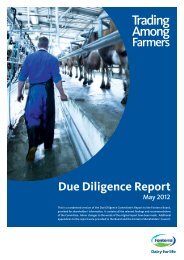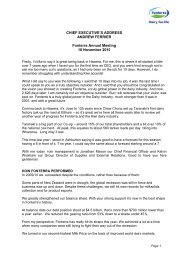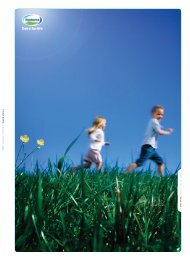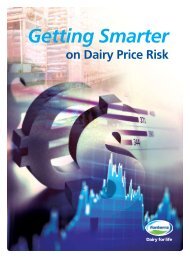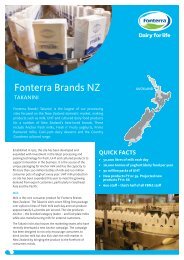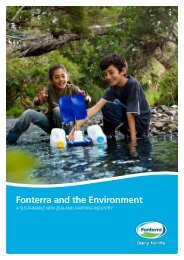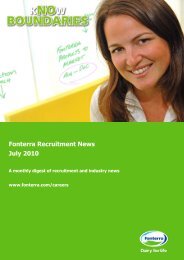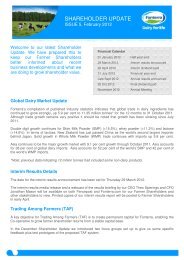A Fonterra Guide to Climate Change
A Fonterra Guide to Climate Change
A Fonterra Guide to Climate Change
- No tags were found...
Create successful ePaper yourself
Turn your PDF publications into a flip-book with our unique Google optimized e-Paper software.
• 5 per cent ‘Distribution’, covering the transportation of the product from the manufacturing site, <strong>to</strong> thewarehouse, and its shipping <strong>to</strong> key destinations internationally.• <strong>Fonterra</strong>’s eco-efficiency programme met its 90 per cent recycling and re-use target in 2009. Since 2003, more than18,000 <strong>to</strong>nnes of paper, cardboard and plastic as well as a huge amount of organic waste has been diverted awayfrom landfill. These savings are equivalent <strong>to</strong> 7450 <strong>to</strong>nnes of greenhouse gas emissions.• We are investing in leading edge research, in partnership with Government, <strong>to</strong> find practical ways of reducingagricultural greenhouse gases. Together the agriculture sec<strong>to</strong>r and the Government have already invested NZ$27.5million since 2002 and have committed <strong>to</strong> a further NZ$19.5 million by 2012 in climate change work through thePas<strong>to</strong>ral Greenhouse Gas Consortium, which <strong>Fonterra</strong> helps fund and currently chairs.• <strong>Fonterra</strong> has joined with the Ministry of Agriculture and Forestry, DairyNZ and FertResearch <strong>to</strong> fund trials testing theeffectiveness of nitrification inhibi<strong>to</strong>rs in different regions throughout New Zealand. These trials will provide farmerswith the information they require <strong>to</strong> make educated management decisions on the application of nitrificationinhibi<strong>to</strong>rs <strong>to</strong> their farms.E: CLIMATE CHANGE AND THE FARMHow do animal emissions occur?Microbes in the rumen of the cow digest the pasture, provide energy for the cow and produce carbon dioxide andhydrogen as a result. A group of micro-organisms, called methanogens, convert carbon dioxide and hydrogen <strong>to</strong>methane, which is burped out by the cow. Between 5-8 per cent of food energy consumed is not converted <strong>to</strong> a formusable <strong>to</strong> the cow and is lost as methane.Nitrogen contained in pasture consumed by the cow, which is not absorbed in milk or meat, is excreted in the urineand faeces of the cow and can then be converted by soil microbes <strong>to</strong> another potent greenhouse gas, nitrous oxide.Nitrogen fertilisers are a further source of nitrous oxide emissions,Methane and nitrous oxide are both considered <strong>to</strong> be more potent greenhouse gases than carbon dioxide. Under theKyo<strong>to</strong> Pro<strong>to</strong>col, one kilogram of methane is equivalent in global warming potential <strong>to</strong> 21 kilograms of carbon dioxide,and one kilogram of nitrous oxide is equivalent <strong>to</strong> 310 kilograms of carbon dioxide. These values will be used for the12





